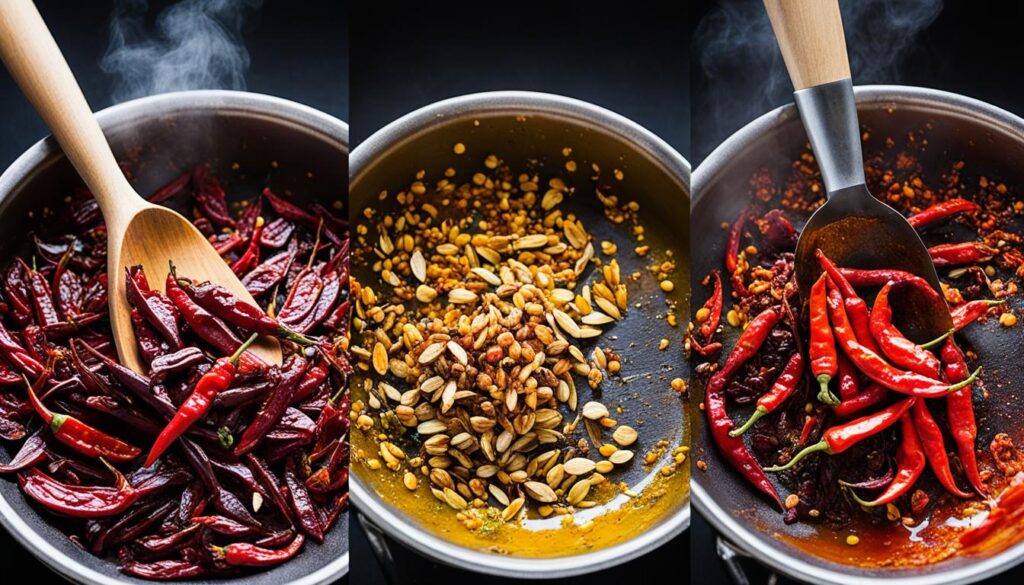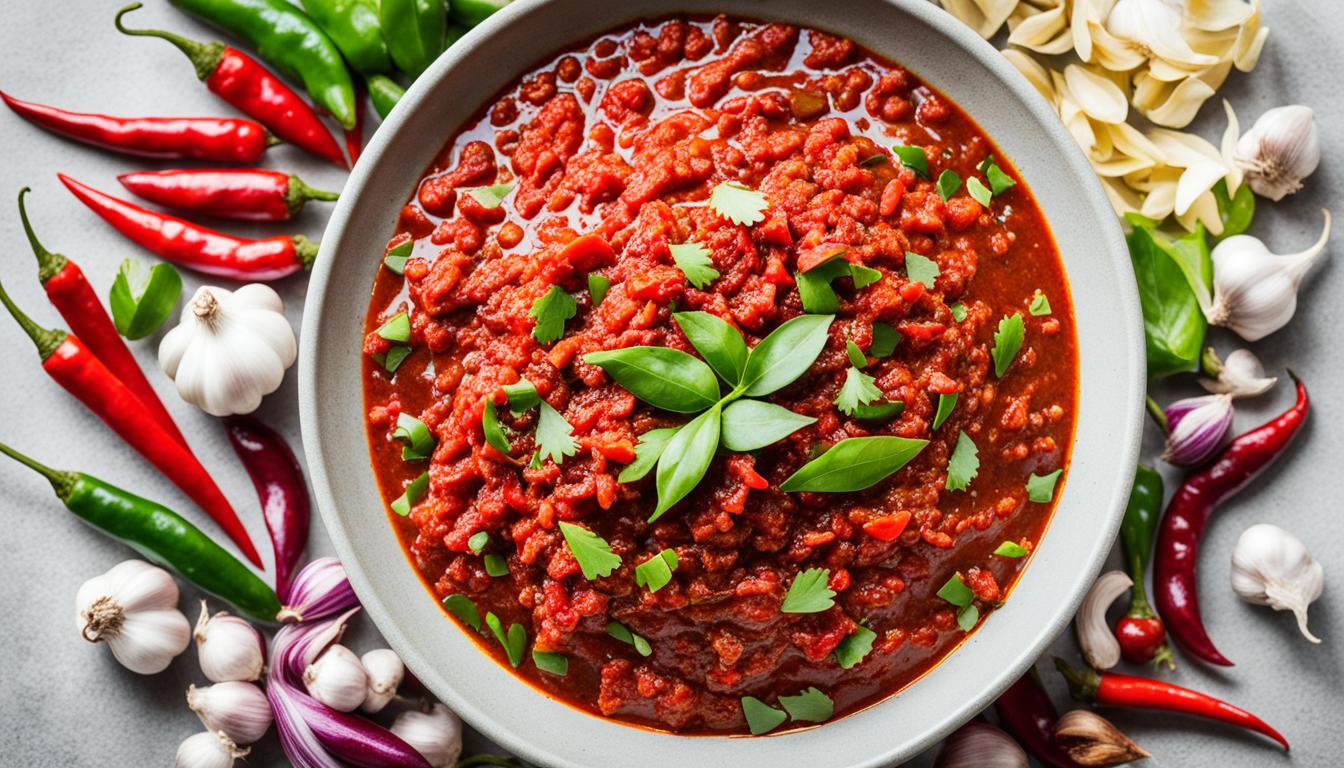Did you know that the average Malaysian consumes a staggering 50 grams of chili paste per day? This fiery statistic speaks volumes about the profound role that sambal tumis, or Malaysian chili paste, plays in the culinary heart of the nation. This versatile and beloved condiment is a household staple, gracing the tables of families across the country with its aromatic blend of fresh chilies, shallots, and shrimp paste.
Sambal tumis, the cooked version of dried chili paste, is a true reflection of the Malaysian spirit – bold, unapologetic, and bursting with flavor. Whether served as a sauce or the main component in a spicy dish, this culinary powerhouse is a quintessential part of our Malaysian cuisine. Join us as we uncover the secrets to mastering the art of this spicy condiment and elevate your meals with the authentic taste of belacan (shrimp paste), tamarind juice, and palm sugar.
What is Sambal Tumis Malaysian Chile Paste?
Malaysian sambal tumis, or Malaysian chile paste, is one of the many beloved sauces cherished by Malaysians. This savory, spicy condiment may look unassuming, but it is truly a versatile and indispensable staple in many Malaysian households. We simply must have our sambal with almost everything we eat!
The Versatile and Fiery Malaysian Condiment
Whether it’s roti canai with curry or dhal, stir-fried rice, noodles, or even water spinach (kangkong), sambal tumis is the go-to flavor enhancer that gives our dishes that much-needed fire in our belly. In times of desperation, when we need a quick fix to satisfy our hunger pangs, we often turn to a simple yet satisfying bowl of steamed rice accompanied by nothing more than a generous spoonful of this aromatic blend of chilies, shallots, and belacan (shrimp paste).
A Beloved Household Staple for Malaysians
In fact, sambal tumis is the indisputable star ingredient in the beloved Malaysian dish, nasi lemak (Malaysian coconut rice). This versatile spicy condiment is truly a cherished household staple that has become an integral part of the Malaysian culinary landscape.
Mastering the Art of Pecah Minyak
At the core of Malay cooking techniques lies the concept of pecah minyak, a crucial step in achieving the perfect oil separation when preparing sambal tumis. This process not only deepens the flavors of the paste but also helps extend its shelf life.
Understanding the Core Concept of Malay Cooking
In Malay cuisine, pecah minyak refers to the stage where the sambal tumis paste has been cooked to the point where the oil separates from the other ingredients. This separation is a visual cue that the paste has been thoroughly cooked, allowing the flavors to meld and the moisture to be driven off, resulting in a more concentrated and flavorful end product.
Achieving the Perfect Oil Separation
Mastering the art of pecah minyak is essential for creating an authentic sambal tumis. By continuously stirring and cooking the paste over medium heat, we can gradually coax the oil separation to occur, revealing the true depth of flavor in the Malay cooking techniques.
Tips for Successful Pecah Minyak
To achieve the perfect pecah minyak, follow these tips:
- Patience and vigilance are key – the process can take 10-15 minutes of constant stirring and monitoring.
- Maintain a medium heat to gradually drive off the moisture without burning the paste.
- Be attentive to the visual cues – the paste will become darker, thicker, and the oil separation will become more pronounced.
- Adjust the heat as needed to prevent burning and ensure the sambal tumis cooking process is executed flawlessly.

Sambal Tumis Malaysian Chile Paste Recipe
Preparing the perfect sambal tumis, or Malaysian chile paste, is a time-honored tradition that showcases the vibrant flavors of Southeast Asian cuisine. This recipe celebrates the aromatic blend of dried chilies, shallots, and belacan (fermented shrimp paste) that makes this homemade sambal tumis a beloved household staple.
Ingredients and Preparation
To make this sambal tumis recipe, you’ll need a few key ingredients: dried chilies, shallots, garlic, belacan, tamarind juice, and palm sugar. Start by soaking the dried chilies in hot water until softened, then drain and chop them finely. Finely chop the shallots and garlic as well.
Cooking the Sambal Tumis
In a skillet or wok, sauté the shallots and garlic in oil until fragrant. Add the chopped dried chilies and belacan, and continue cooking until the mixture releases its aromatic oils, a process known as pecah minyak. Stir in the tamarind juice and palm sugar, adjusting the seasoning to your taste. Cook the sambal tumis until it reaches the desired consistency, being mindful not to let it dry out completely.
Serving Suggestions and Pairings
This Malaysian chile paste is a versatile condiment that can be enjoyed with a variety of dishes. Serve it as a dipping sauce for roti canai, or use it to stir-fry rice, noodles, or water spinach (kangkong). It’s also a key component in the beloved nasi lemak (Malaysian coconut rice) dish. For a quick fix, simply pair the sambal tumis with steamed rice and a protein of your choice.
Variations and Substitutions
While the traditional sambal tumis is undoubtedly delicious, there are a few variations and substitutes you can explore to suit your taste preferences or ingredient availability. One popular alternative is sambal oelek, the Indonesian version of the chili paste. Oelek refers to the “mashed” or “pounded” texture, and this variant typically uses fresh red chilies instead of dried ones, resulting in a more vibrant and fresh-tasting condiment.
For those seeking a different flavor profile, harissa, a North African chili paste, can be a suitable substitute. Harissa is made with a blend of chilies, garlic, spices, and sometimes tomatoes or olive oil, providing a unique and complex taste that can complement various dishes. While not an exact replica, harissa can add a delightful twist to your culinary creations when sambal tumis is not available.
Remember, the joy of cooking lies in experimentation and exploring new flavors. Feel free to experiment with different sambal variations or chili paste substitutes to find the one that best suits your taste buds. The key is to keep an open mind and embrace the diversity of culinary traditions from around the world.
